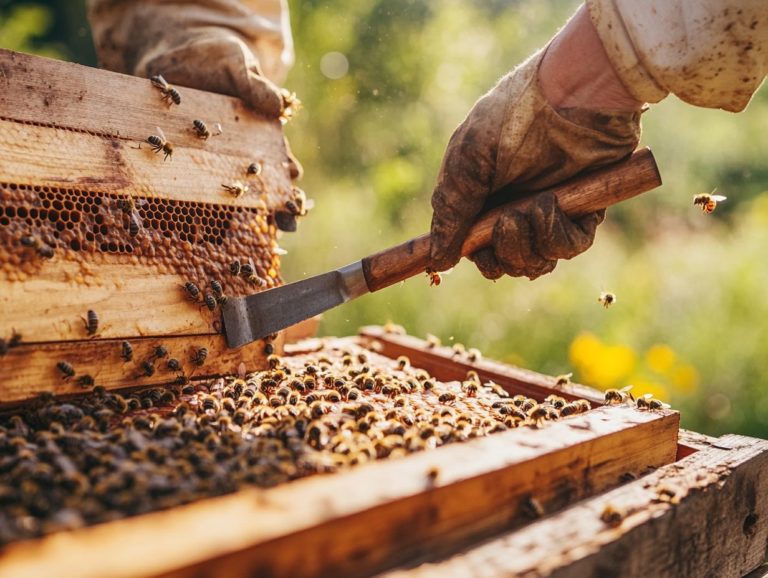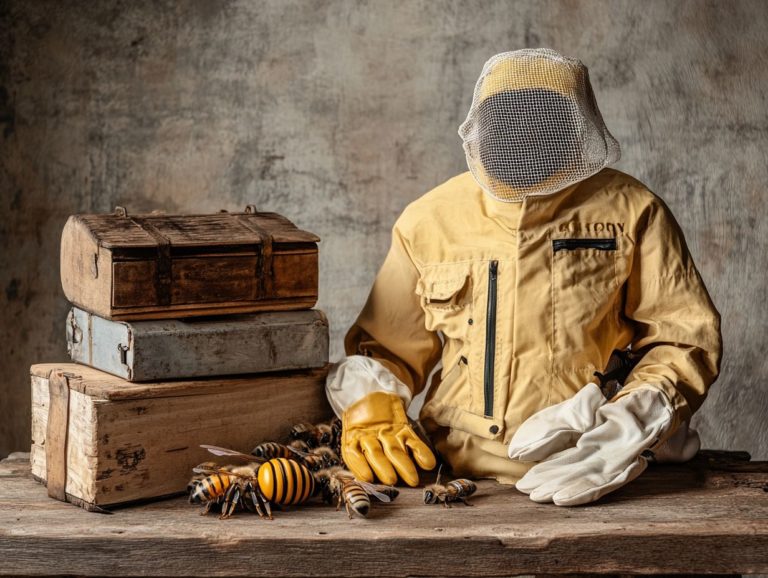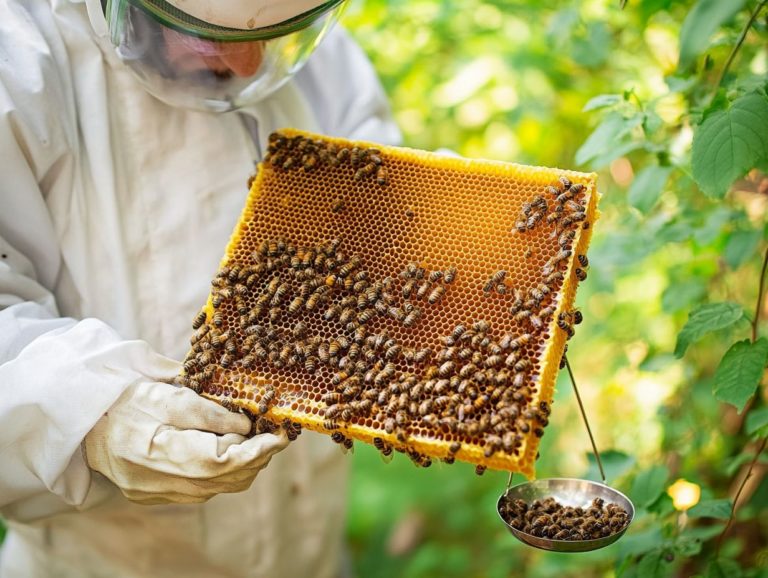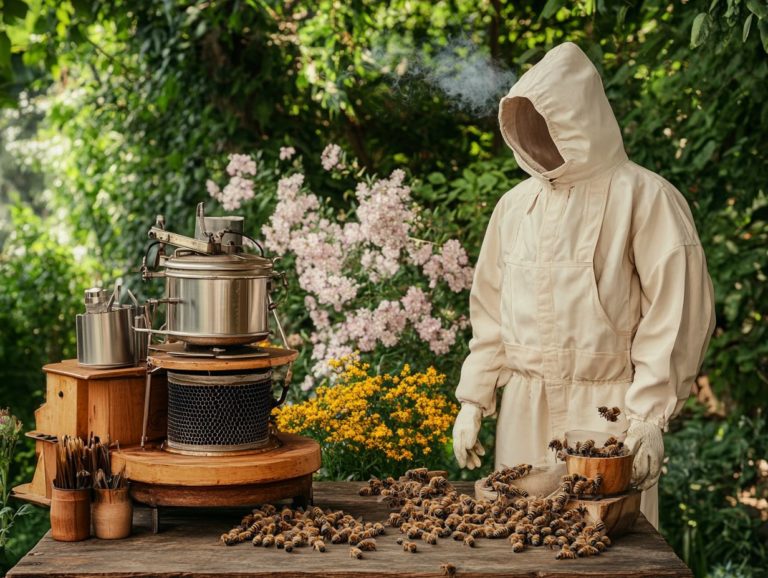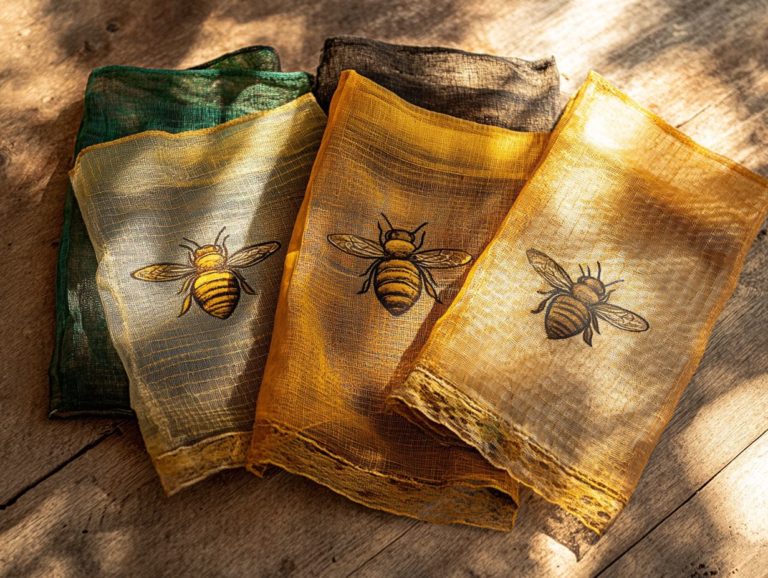Beekeeping Gloves: What You Need to Know
Beekeeping presents a delightful blend of reward and challenge. Having the right protective gear is fundamental to ensuring a safe and enjoyable experience.
Among the essential equipment for any beekeeper, a high-quality pair of beekeeping gloves stands out as a critical investment. These gloves shield you from potential bee stings and bolster your confidence when working with bees.
This guide explains why beekeeping gloves are important, explores the various types available, and offers insights on selecting the perfect fit. It also provides tips for proper care to extend the life of your beekeeping equipment.
You will find discussions on alternatives and beekeeping safety tips to guarantee that your beekeeping ventures are both safe and successful.
Whether you re a seasoned beekeeper or just starting this fascinating journey, this guide will give you everything you need to navigate the world of beekeeping gloves effectively.
Contents
- Key Takeaways:
- What Are Beekeeping Gloves?
- Why Are Beekeeping Gloves Important?
- What Types of Beekeeping Gloves Are Available?
- How to Choose the Right Size of Beekeeping Gloves?
- How to Properly Wear Beekeeping Gloves?
- How to Take Care of Beekeeping Gloves?
- What Are the Alternatives to Beekeeping Gloves?
- What Are the Safety Precautions When Using Beekeeping Gloves?
- Frequently Asked Questions
- What are beekeeping gloves and why are they important?
- What types of materials are beekeeping gloves made of?
- How do I choose the right size beekeeping gloves?
- Can I reuse my beekeeping gloves, or should I consider disposable gloves?
- Do I need to wear beekeeping gloves every time I work with my bees?
- Are there any other protective gear I should wear while beekeeping?
Key Takeaways:
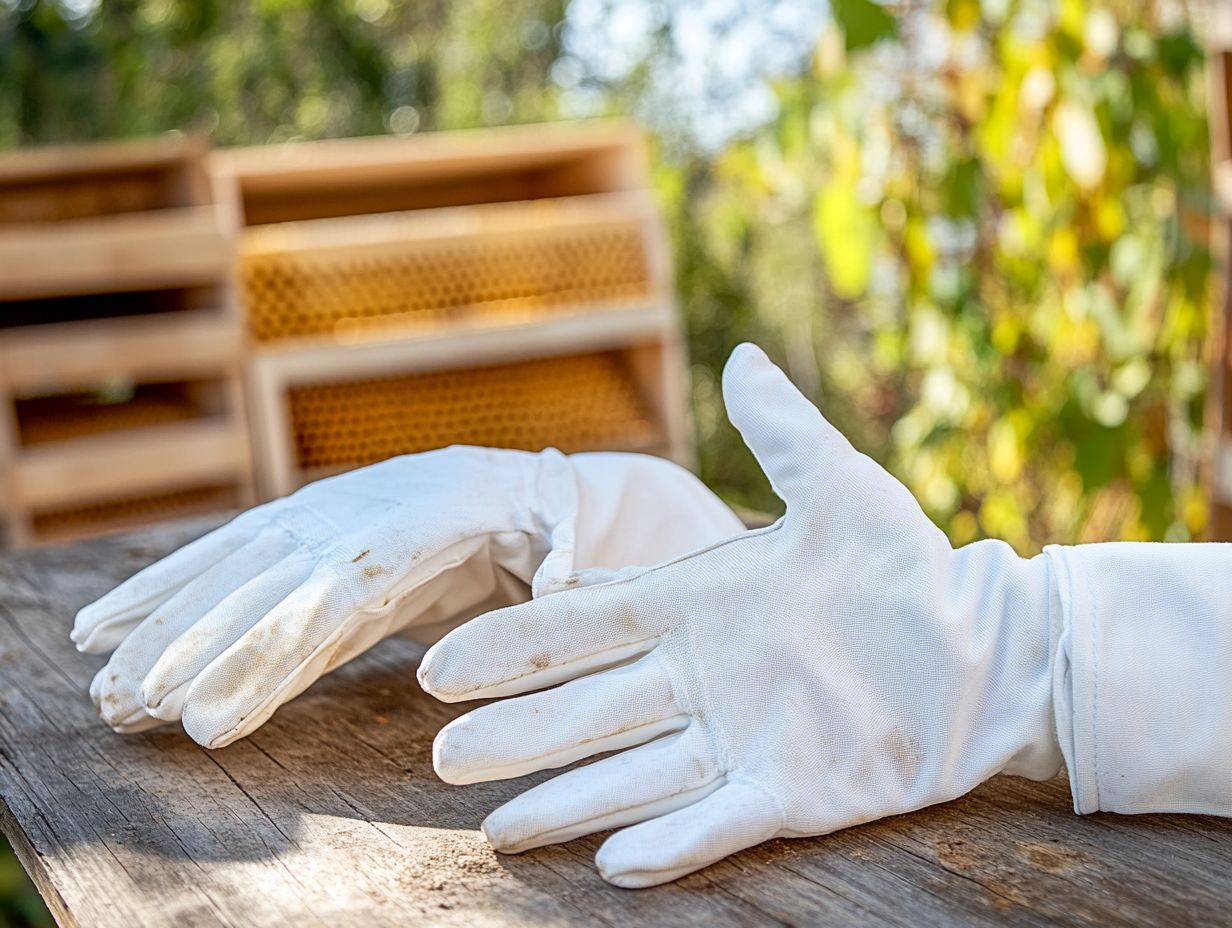
- Beekeeping gloves are essential protective gear for beekeepers, preventing bee stings and potential allergic reactions from bee venom.
- Investing in high-quality, properly fitting beekeeping gloves is crucial for safety and comfort during beekeeping activities. It s important to choose the right fit for maximum protection.
- Proper care and maintenance of beekeeping gloves are necessary to prolong their lifespan and ensure effective protection against bee stings.
What Are Beekeeping Gloves?
Beekeeping gloves are an essential piece of protective gear crafted to safeguard you from bee stings while you inspect hives or interact with these remarkable creatures. Wearing gloves ensures sting-proof safety and confidence during hive inspections.
Available in a variety of materials, including nitrile and leather, each type offers distinct advantages and varying levels of protection. Identifying the best beekeeping gloves is essential for effective bee handling, as they provide the proper protection, coverage, and dexterity you need to work safely and confidently.
Renowned brands like Walter T. Kelley, along with options found on platforms such as Amazon, present a diverse selection of gloves tailored to suit your unique needs and preferences as a beekeeper. Be sure to choose based on material and fit for maximum effectiveness.
Why Are Beekeeping Gloves Important?
Beekeeping gloves are essential for any beekeeper who prioritizes safety both yours and the bees’ during hive inspections and management. By wearing gloves, you shield yourself from painful bee stings and ensure proper protection, allowing you to approach your tasks with a greater sense of confidence and effectiveness.
This added layer of protection not only reduces the risks of allergic reactions but also alleviates any anxiety you might feel while working around hives. Choosing well-fitted gloves enhances your comfort and dexterity, making it easier to handle beekeeping equipment and perform delicate tasks with finesse.
What Are the Risks of Beekeeping Without Gloves?
Beekeeping without gloves carries significant risks, particularly the chance of painful stings and severe allergic reactions that could have serious implications for your health. Your hands are especially vulnerable to stings, and even the most experienced beekeepers can find themselves unexpectedly on the receiving end of a bee’s wrath.
By forgoing proper protection, you increase your risk of injury, which can lead to a less enjoyable and potentially hazardous beekeeping experience. The emotional consequences of these risks can be just as impactful; one sting can trigger heightened anxiety or fear, ultimately shaking your confidence and willingness to connect with the bees.
Allergic reactions, ranging from mild irritation to life-threatening anaphylaxis an extreme reaction that can be life-threatening without immediate treatment can strike without warning, underscoring the necessity of safety measures. If you choose to work without protective gear, your passion for this rewarding hobby may begin to wane, as the threat of injury overshadows the sheer joy of engaging with these remarkable insects.
Implementing proper safety precautions, including the use of gloves, is essential for creating a secure environment for both you and the bees.
We encourage you to share your beekeeping experiences or ask questions to foster community engagement!
What Types of Beekeeping Gloves Are Available?
You can choose from many types of beekeeping gloves to fit your needs. Each type is designed to provide different levels of protection, comfort, and dexterity.
Leather gloves offer durability and strong defense against bee stings. On the other hand, if you need better movement, nitrile gloves are a great option, especially for beginners.
Working in warm weather? Choose ventilated gloves made from breathable materials to keep your hands cool. If you require extra protection for your forearms, consider long-cuffed gloves.
It’s important to pick gloves that match your specific beekeeping tasks. Different gloves help maintain comfort through varying weather conditions.
What Are the Differences Between Leather and Synthetic Gloves?
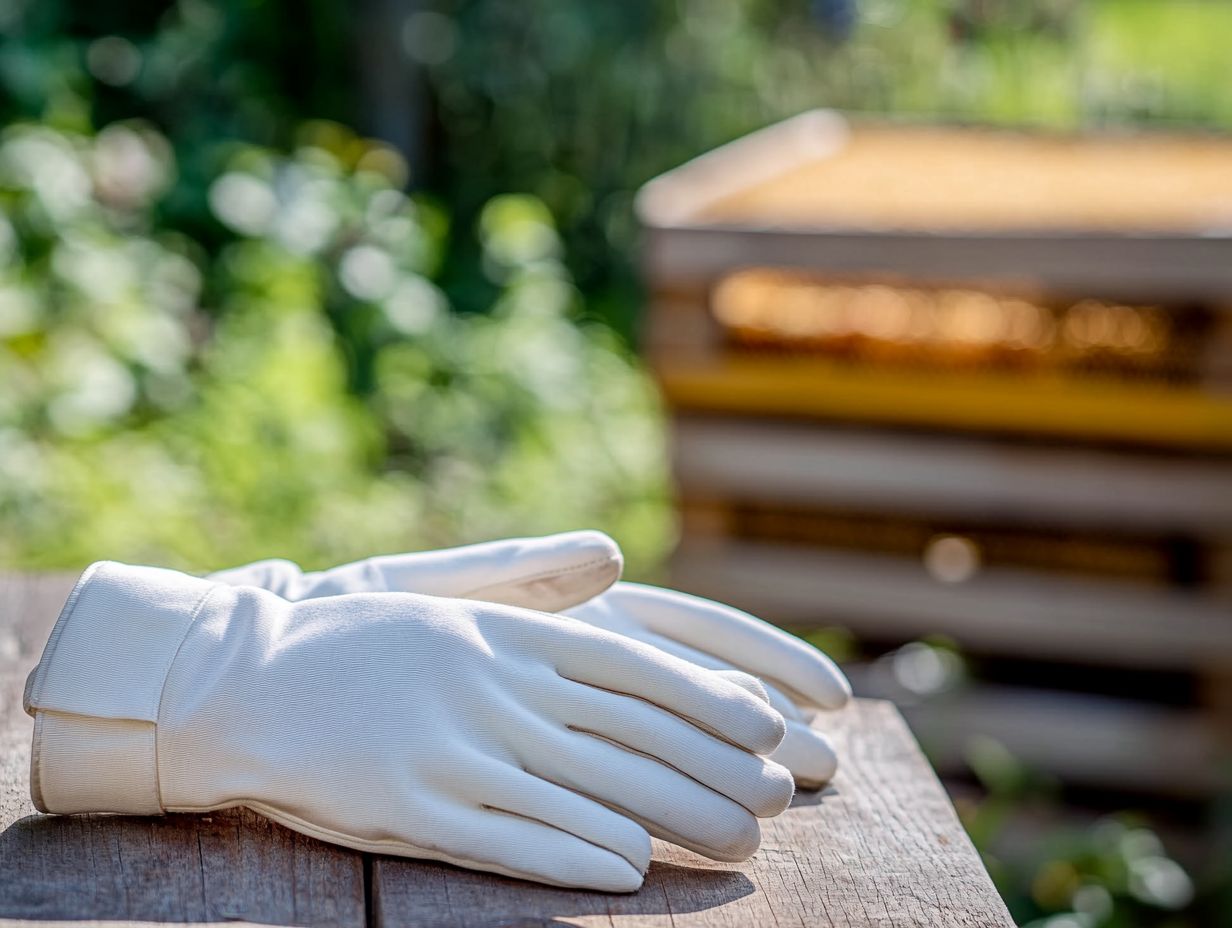
Choosing between leather and synthetic gloves, like nitrile, depends on durability, comfort, and dexterity. These factors appeal to different types of beekeepers.
Leather gloves, especially those made from goatskin, are known for their long-lasting durability. They’re favored by experienced beekeepers who need reliable gear.
Synthetic gloves, like nitrile, offer a good balance of comfort and dexterity. They’re ideal for tasks that require precise movements, such as inspecting hives.
The materials in leather gloves create a natural barrier against sharp objects. Synthetic gloves are more versatile and can resist chemicals in various environments.
While leather gloves might feel bulkier, they provide breathability on hot days. Synthetic options, however, fit snugly for better handling of tools.
As a beekeeper, consider the benefits of each glove type against your specific needs. Make the best choice for your beekeeping experience!
What Are the Benefits of Ventilated Gloves?
Ventilated gloves offer great benefits when the heat is on. Made from breathable materials, they keep your hands cool and safe from bee stings.
If you work in high heat or spend long hours outdoors, you ll love how these gloves minimize sweat buildup.
They also elevate your overall comfort. By ensuring a proper fit and ventilation, you can maintain the ability to move your fingers easily and grip essentials needed to handle bees and beekeeping equipment effectively.
Choosing gloves in varying sizes and conditions is important to suit specific tasks and climates.
These gloves also come equipped with mesh panels or perforated materials that promote airflow, keeping your hands dry.
This thoughtful design not only reduces the risk of overheating but also helps prevent skin irritation an essential consideration during long periods of active bee management.
Well-ventilated gloves are crucial for long-term comfort and effectiveness.
The lightweight nature of ventilated gloves translates into less hand fatigue, allowing you to focus on your important tasks without the nagging distraction of discomfort.
Choosing materials that balance comfort and dexterity can make a significant difference in your beekeeping experience.
In the end, opting for ventilated gloves can significantly elevate your beekeeping experience, particularly during those sweltering summer months.
Gloves for women may also come in more ergonomic designs, ensuring that everyone can find a pair that fits well and provides the necessary protection.
What Are the Advantages of Long-Cuffed Gloves?
Long-cuffed gloves are carefully crafted to provide extra protection for your forearms. This makes them particularly beneficial when inspecting hives or engaging in other beekeeping activities.
These gloves extend coverage beyond your wrists, effectively preventing bees from crawling up your arms an important consideration with aggressive colonies.
With various sizes available, you can achieve a snug fit. This allows you to approach your bee interactions with complete confidence.
Choosing gloves for inspections and different conditions carefully ensures full coverage and protection.
The robust design of these gloves incorporates materials that blend flexibility with durability.
This allows you to move easily while handling frames or tools. You can cinch the long cuffs securely, creating an effective barrier against pesky insects.
This additional layer of protection also minimizes the risk of allergic reactions to stings, making these gloves essential for novice and seasoned beekeepers alike.
By investing in quality construction and thoughtful design, you re prioritizing safety in your beekeeping endeavors.
These gloves are more than just an accessory; they re a critical investment that fosters your confidence during potentially hazardous encounters with lively bee populations.
Whenever possible, avoid buying gloves online. Trying them in-store can help ensure the best fit.
How to Choose the Right Size of Beekeeping Gloves?
Choosing the right size of beekeeping gloves is essential for your comfort and protection during hive inspections. When your gloves fit well, you ll notice a significant boost in dexterity and overall experience.
A proper fit enables you to handle tools and manage bees with ease while reducing the risk of stings or discomfort during longer sessions.
As you select your gloves, keep in mind the balance between comfort and flexibility. Explore the various sizes available to find a snug yet comfortable fit tailored just for you, whether you buy gloves in-store or order them online.
To achieve the ideal blend of protection and functionality, make sure to measure your hands accurately, considering both length and circumference.
It s also wise to try on different sizes and styles, as manufacturers may have varying sizing charts.
The choice of material matters as well; for example, leather gloves provide durability and a solid grip, while nitrile gloves offer superior flexibility.
By understanding these sizing nuances, you ll ensure that your gloves fit comfortably and support you in your essential beekeeping tasks without any hindrance.
How to Properly Wear Beekeeping Gloves?
Properly wearing beekeeping gloves is essential for enhancing your safety and ensuring effective bee handling during hive inspections or other beekeeping activities. It s crucial to select gloves that fit well and are securely fastened to prevent accidental slips, which could expose you to the sting of a bee.
Understanding the right techniques for putting on your gloves and ensuring they are free from tears or damage can bolster your protection. This allows you to focus on your work without worry. This is particularly vital for beginners, who might not yet have the skill to handle bees with bare hands.
- Start by choosing gloves that offer a comfortable fit that feels secure. Ensure they provide proper protection and dexterity. If they re too loose, they might snag on your equipment, while overly tight gloves can restrict your movement.
- Slide the gloves on, making sure the wrist area is fully covered, as this is a common entry point for sneaky bees.
- Secure the wrist fastenings be they elastic bands or Velcro straps to create a tight seal. This keeps buzzing creatures at bay and ensures the gloves fit well around your wrist.
Before you dive into any beekeeping activity, inspect your gloves for signs of wear, such as holes or frays. These can seriously compromise their protective qualities. By following these steps, you can ensure that you re well-protected while working with your bees. It’s smart to consider gloves designed for different types and weather conditions.
How to Take Care of Beekeeping Gloves?
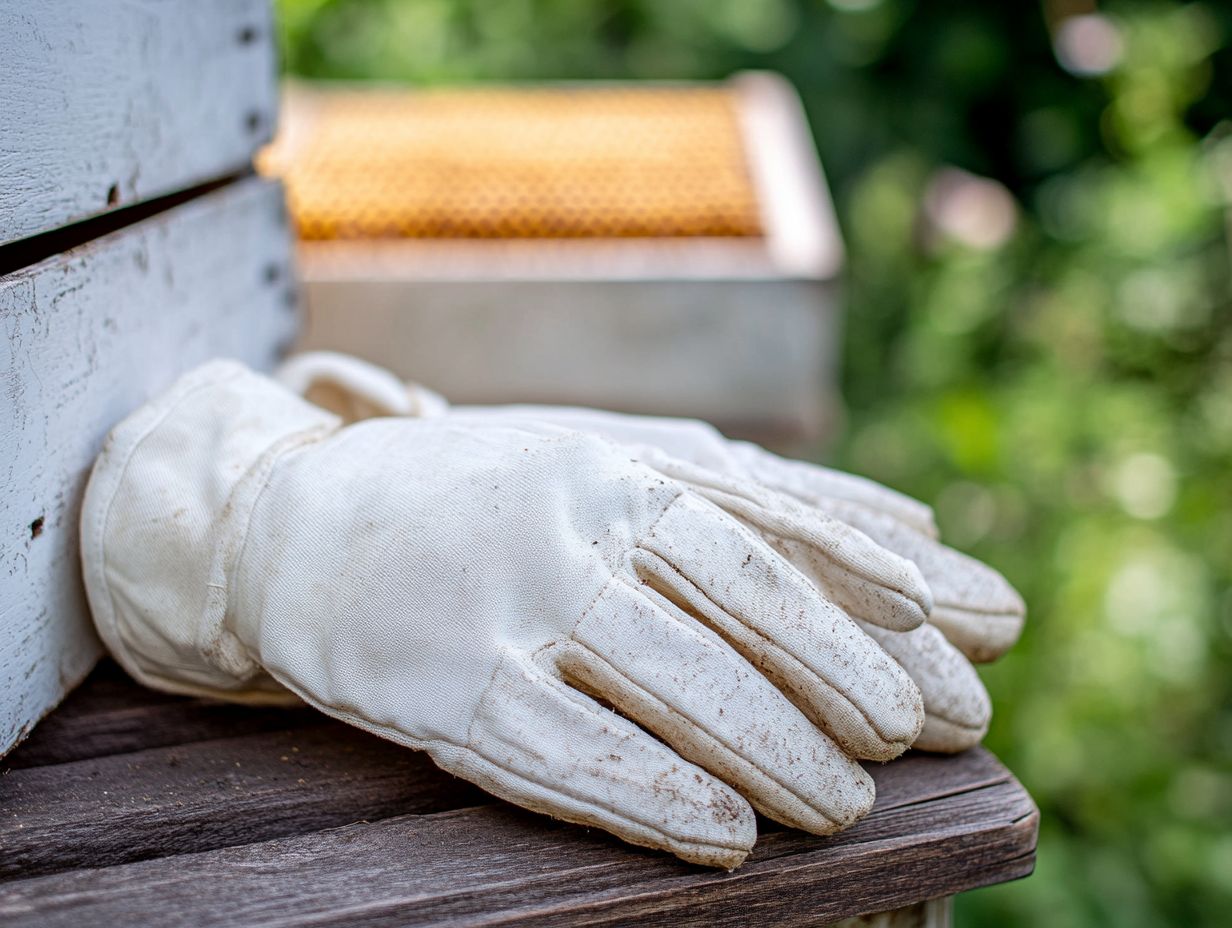
Maintaining your beekeeping gloves is essential for ensuring their longevity and effectiveness in protecting you from bee stings. Proper care means regularly cleaning, inspecting for signs of wear, and storing them correctly. By following a few straightforward maintenance steps, you can keep your gloves in optimal condition.
This allows you to enjoy the full benefits of protection while handling your bees and inspecting hives. Whether you are using leather gloves, nitrile gloves, or any other material, proper maintenance is key.
- After each use, gently wash your gloves with mild soap and lukewarm water. This helps ensure that dirt and honey residues don t compromise the material, particularly for gloves in-store, as in-store gloves have been tried on multiple times.
- During your inspection, look for any cracks, punctures, or fraying seams that might weaken the gloves’ protective capabilities.
- It s important to air dry your gloves away from direct sunlight. Excessive heat can degrade the materials over time.
For optimal storage, find a cool, dry place to keep them, ideally in a breathable cloth bag. This simple step can significantly extend the lifespan of these essential tools. Regular maintenance keeps your gloves in good condition and ensures they provide effective protection.
What Are the Alternatives to Beekeeping Gloves?
While beekeeping gloves are a common choice for safeguarding against bee stings, consider alternatives some beekeepers favor, such as using a smoker or handling bees with bare hands.
Employing a smoker can soothe the bees, transforming hive inspections into a more tranquil experience. This method can make your warm-weather inspections much more comfortable!
However, if you choose to handle bees without gloves, be prepared to showcase a high level of confidence and skill, along with a profound understanding of the bees’ behavior and reactions. Transitioning to gloveless beekeeping requires significant experience and the right approach to bee handling.
What methods do you prefer for protecting yourself while beekeeping?
What Are the Pros and Cons of Using Smoker Instead of Gloves?
Using a smoker instead of gloves for handling bees can offer you distinct advantages, such as calming the bees and reducing the likelihood of stings, which ultimately enhances your overall safety during inspections. However, it’s important to weigh the significant drawbacks as well, including the risk of overwhelming smoke that can disorient the bees and the necessity for skillful smoker management to ensure effective handling. You’ll want to consider these factors carefully to determine the best approach for your specific needs.
For instance, the gentle application of smoke can foster a tranquil atmosphere that minimizes aggressive behavior, making the inspection process smoother. This is particularly advantageous if you’re dealing with anxious or temperamental colonies.
On the flip side, relying solely on gloves may provide you with that extra layer of physical protection, allowing you to feel more secure while managing your hives. Yet, this can create a barrier that might limit your interaction with the bees. It’s essential to choose the right fit and the best beekeeping gloves for your needs.
Ultimately, whether you choose a smoker or gloves hinges on your level of experience, your comfort in handling bees, and the unique dynamics of your hive situation. Consider the comfort dexterity tradeoff when making your decision.
What Are the Benefits of Using Bare Hands for Beekeeping?
Using bare hands for beekeeping can offer you unique advantages, such as heightened tactile sensitivity and a deeper understanding of the bees’ behavior, ultimately leading to more effective handling. As you gain experience, you may discover that working without gloves grants you greater dexterity and control when interacting with these fascinating creatures.
However, this approach is not without its risks, especially for beginners who might be more vulnerable to bee stings and should proceed with caution.
By removing the barrier that gloves create, you often find that you can sense the subtle cues from the bees, allowing for quicker adjustments during hive inspections. This tactile connection enhances your ability to gauge the colony’s mood, potentially leading to better decision-making regarding the hive’s health. Gloves that breathe are an alternative for those who want some hand sensitivity while still having a layer of protection.
Nonetheless, this hands-on approach demands a level of confidence and experience; inexperienced keepers may feel overwhelmed by the bees’ reactions. Even seasoned beekeepers recognize that bee stings are an inevitable aspect of the journey, making it crucial to balance the advantages of bare-hand beekeeping with a thorough understanding of bee behavior and your own personal risk tolerance.
What Are the Safety Precautions When Using Beekeeping Gloves?
When you re using beekeeping gloves, it s essential to adhere to specific safety precautions that will maximize your protection against bee stings and facilitate effective bee handling. Regularly inspect your gloves for signs of wear, and ensure they fit snugly to maintain the dexterity you need while managing equipment and inspecting hives. Consistently following these beekeeping safety tips will greatly reduce the risk of stings.
Gaining an understanding of bee behavior and employing mindful techniques can significantly enhance your safety during interactions, transforming the experience into something both productive and enjoyable.
Selecting gloves that fit well is key; a snug fit will help you avoid mishaps while handling frames or tools, as loose gloves can hinder your movements and introduce unnecessary risks. Practice gentle motions, as sudden movements can provoke bees and heighten the chance of stings. Staying calm during inspections is crucial, as bees can sense agitation and may react accordingly.
Opt for gloves made from breathable materials to minimize sweat buildup, allowing for a more comfortable experience during prolonged use while maintaining grip and control. By incorporating these safety measures, you can foster a more harmonious relationship with your bees and ensure successful hive management.
Frequently Asked Questions
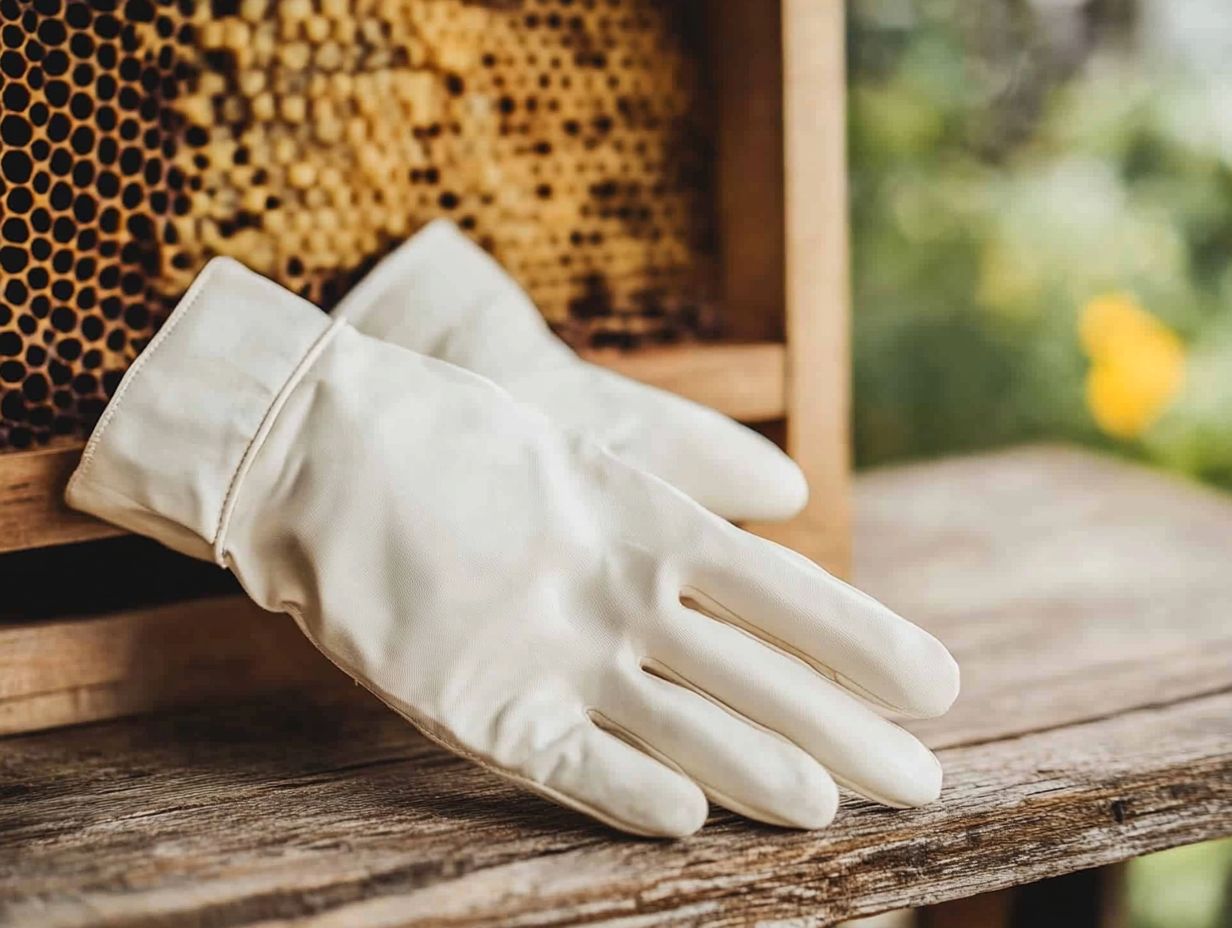
What are beekeeping gloves and why are they important?
Beekeeping gloves protect your hands and arms from bee stings. They are essential for preventing stings and allergic reactions. Choose the right fit to ensure safety and ease of movement.
What types of materials are beekeeping gloves made of?
Beekeeping gloves are usually made of leather, canvas, or rubber. Leather gloves are durable, while canvas gloves are lightweight. Rubber gloves are perfect for those allergic to bee stings. Nitrile gloves offer great flexibility and comfort!
How do I choose the right size beekeeping gloves?
Choose gloves that fit well for maximum protection. Measure from your palm’s base to your middle finger’s tip and use the sizing chart from the manufacturer.
Can I reuse my beekeeping gloves, or should I consider disposable gloves?
You can reuse your gloves if they are in good shape. Wash them after every use with mild soap and warm water. Always check for tears or holes before using them!
Do I need to wear beekeeping gloves every time I work with my bees?
It’s best to wear gloves every time, especially as a beginner. The right fit ensures safety and comfort. As you gain experience, you may feel confident enough to go without them!
Are there any other protective gear I should wear while beekeeping?
Yes! Besides gloves, wear a beekeeping suit or jacket, a veil or hat, and closed-toe shoes. This gear protects your whole body from bee stings.

